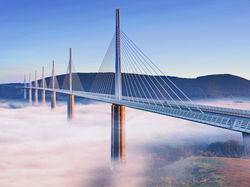
 FR0012_1299_MillauFINMAIN2-reduced.jpg |  landscapes_france_fog_millau_v_2560x1920_knowledgehi.com.jpg |  15584568.jpg |
|---|---|---|
 Millau_Viaduct_overall_view.jpg |  2000px-Viaduc-Millau_Pile-P2_Eiffel.svg.png |  MILLAU VIADUCT.jpg |
 BRIDGE.jpg |
MILLAU VIADUCT BRIDGE
The Millau Bridge is in southern France and crosses the River Tarn in the Massif Central mountains. At 300m (984 feet) it is the highest road bridge in the world, weighing 36,000 tonnes. The central pillar is higher than the famous French icon, the Eiffel Tower (central pillar at 343 m high ; Eiffel at 324 m high). The bridge towers above the Tarn Valley and the aim of Norman Foster was to design a bridge with the ‘delicacy of a butter fly’. Norman Foster designed a bridge that enhances the natural beauty of the valley, with the environment dominating the scene rather than the bridge. The bridge appears to float on the clouds despite the fact that it has seven pillars and a roadway of 1½ miles in length. On first sight, the impression is of boats sailing on a sea of mist. The roadway threads through the seven pillars like thread through the eye of a needle. The bridge was opened by President Jacques Chirac. In his speech he praised the design saying that it was a ‘monument to French engineering genius’ and ‘a miracle of equilibrium’.
Norman Foster designed this bridge and made it look so delicate (as delicate as a butterfly) at the same time made it structurally stable. Norman Foster achieved his goal of making the natural beauty of the valley dominate the scene rather than the bridge by making his design of the pillars look as thin as needle when viewed as a part of the whole scene of the valley.
